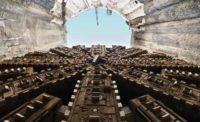By now, everyone knows that "Bertha," the world’s largest tunnel boring machine, was stuck in Seattle’s subsoil for more than a year, since December 6, 2013. Bertha is now back underground and current plans call for a restart of tunneling on November 23, with project completion in early 2018. Over $1 billion of the approximate $1.4-billion contract has been invoiced and paid, but only about 10% of the 9,300-ft-long tunnel has been bored. Opponents to the project remain relatively few in number and not too vocal.
I performed an independent risk assessment for the Seattle Dept. of Transportation in 2010, and my report (a public document) essentially predicted what is now unfolding.
But I am a generalist, not an expert, and was not the only person who thought this was not a great idea.
State Route 99 is a state project under the direction of Washington Dept. of Transportation (WSDOT) which, along with an army of consulting firms and experts, has been studying how to respond to the damage to the Alaskan Way Viaduct from the February, 2001 earthquake.
Numerous studies looked at repairing, or replacing, the viaduct and several schemes advanced to concept designs. Voters rejected in a referendum a cut-and-cover tunnel on the waterfront. By 2010, WSDOT favored a Deep Downtown Tunnel scheme to replace the viaduct, running from south to north, mostly under the city.
At that time, opponents to this plan said it was a bad idea because the city would have been liable for the cost of any overruns. However, the opposition was unable to alter the process.
WSDOT pre-qualified four team to bid on the design-build contract, but two dropped out prior to bid opening. WSDOT awarded the contract to the high bidder, Seattle Tunnel Partners (STP), composed of Dragados-U.S., Tutor-Perini, and HNTB. The main reason this team won is it claimed it could finish the contract 12 months ahead of the planned schedule. STP selected Hitachi-Zozen to build the TBM, and began work. The actual tunneling started in the summer of 2013. Depite minor problems, the tunneling made progress until the fateful day.
I believe there are many smoking guns, because today’s situation is the result of all the decisions and actions made in the last 14 years made by all the players on all sides of the table. A lot of smart, well-intentioned people were trying to do the right thing. Their decisions and actions were essentially predictions and more than a few of them were incorrect.
Signal and Noise
Nate Silver offers a clear explanation why this happened in his best-selling book "The Signal and the Noise: Why So Many Predictions Fail, But Some Don’t." Tunneling in an urban environment is not a "data-rich" enterprise, as is, for example, baseball. So correct predictions are very difficult to achieve.
Why did it go wrong? Maybe the process was flawed. One might suggest that WSDOT’s Cost Estimation Validation Process, which largely employs probability theory to assess risk, might not have been the best process to help justify to project. Bent Flyvbjerg, a professor at the Said Business School at Oxford University, cites optimism bias, or in plain language, delusions, and strategic misrepresentation, or deception, as two primary, and consistent, reasons for bad outcomes of large, complex infrastructure projects. He also believes that these bad outcomes often relate to situations where transportation planning overrides comprehensive land-use (city) planning. Again, competent, well-meaning people making decisions and taking actions over a long period of time.

NEFF
How is this going to end? My opinion is that neither side will be happy, but one side, that is, WSDOT and their team or STP and their team, will be less unhappy than the other. Citizens and tax- payers, as always, will take what they get.
Given the evidence to date, my opinion is that Bertha will not finish the tunnel, but that some other machine, or process might. The project will likely not be complete in early 2018, and much more money will be required.
This situation reminds me of the famous quote from Italo Calvino: “You know that the best you can expect is to avoid the worst.” In this case, the worst outcome would be two completed portals no connecting tunnel, and a very long court battle. Yikes!
Thom Neff is president of OckhamKonsult, a Boston-based strategic infrastructure management consultant. He can be reached at tompino38@gmail.com.


Post a comment to this article
Report Abusive Comment